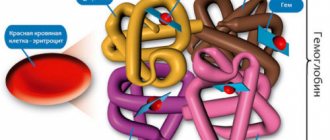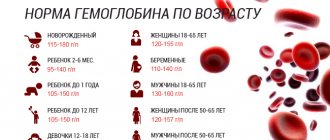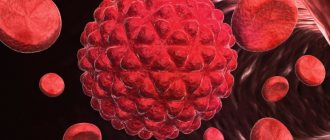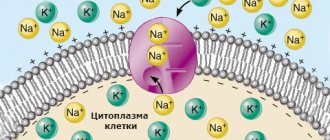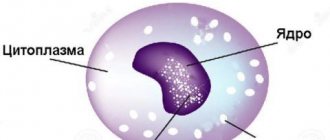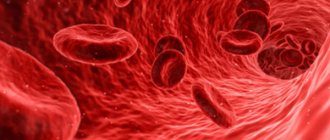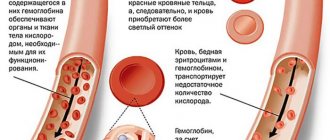The color indicator of blood is an important characteristic that is used during the study of blood cells, red blood cells and other components. It is he who indicates the qualitative composition of the red liquid. Thanks to special tests in laboratory conditions, it is possible to determine the color index (CIC), calculate its norm and possible deviations. A special formula is used to measure the number of red blood cells and hemoglobin in the serum. This information is intended for further diagnosis of various diseases. What is the color indicator of blood and how it is calculated, we will consider below.
Designation in blood tests
How is the color indicator indicated in a general blood test? Before the advent of modern laboratory analyzers, the color indicator of blood was designated as CP. The result was recorded in picograms, the norm was 27-33 pg. Then they began to write the result without units of measurement - 0.8-1.1.
In large analyzers, where the analysis form is issued by a computer, the designation is different - MSN . This is an international abbreviation - Mean Corpuscular Hemoglobin. The result is recorded in grams per deciliter, the norm is 32-37 g/dl.
There is another criterion that has a more precise clinical meaning - MSHC. It indicates the degree of hemoglobin saturation of the average red blood cell, calculated as a percentage. The criterion does not depend on gender, age, or race. It can be calculated using the formula - hemoglobin multiplied by 10 and divided by hematocrit, the total volume of red blood cells. The MCHC norm is 4-5%.
What is normochromic anemia
A normal blood color does not always indicate the patient’s health. There is a type of anemia called normochromic. With it, one red blood cell contains, as expected, 33.4 pg of hemoglobin, but the number of blood cells is not enough for the normal functioning of the body.
This type of anemia, or aplastic anemia, occurs due to disturbances in the functioning of the bone marrow, which produces red blood cells.
The disease is dangerous due to its complications and is caused by viral infections such as HIV, hepatitis . Its appearance is associated with genetic abnormalities and the toxic effect of strong drugs on the body.
The resulting failure of the immune system leads to the destruction of bone marrow cells.
Another reason is the development of hemolytic anemia, when red blood cells are constantly destroyed, and new cells do not have time to form. The disease has hereditary and acquired forms and is extremely rare.
Normal blood color index among adults and children
The blood color index is normally higher in children, lower in adults:
- men and women - 0.8-1.1;
- newborns - 0.9-1.3;
- children under 15 years old - 0.85-1.
The color index of a child's blood is higher because fetal hemoglobin is present in his blood. This is a protein that is only present in the fetus during intrauterine development. A week after the birth of the child, it is destroyed, the CPU becomes lower.
There is no separate blood test for color indicator; it is looked at in a general clinical examination. An examination is prescribed if there are symptoms of anemia.
Reasons for increased or decreased CP in a child
If the norm of the color index is too high or too low in a child, then such forms of anemia are identified as:
- hypochromic, when the analysis gives a result of up to 0.86;
- hyperchromic with an indicator above the level of 1.14;
- normochromic, when determining the blood color indicator gives a satisfactory result.
The causes of anemia are the same as in adults. An increased rate also occurs when a child develops kidney failure. And with iron deficiency, attention is paid to changes in liver cells, leading to cirrhosis.
A child can also get hereditary forms of blood diseases. He inherits one of them (thalassemia) due to a mutation in the DNA of the cells that make up hemoglobin. The development of the disease in the fetus can be determined at the mother's stage of pregnancy by taking a sample of amniotic fluid.
Acquired types of anemia in children can be successfully treated with medicine.
Causes of decreased blood color index and main symptoms
When the blood color index is reduced, you need to look for anemia and its cause. A color index below normal in infants indicates anemia in the mother. The child is born pale and underweight.
A low blood color index in older children is observed during periods of intense growth, when the body uses a lot of iron. This is especially pronounced in teenage girls during the formation of the menstrual cycle. Characteristic clinical manifestations:
- pale skin with a greenish tint;
- unmotivated fatigue;
- apathy;
- dizziness, episodes of loss of consciousness.
A low blood color index in women is also associated with gynecological diseases. With fibroids and endometriosis, menstrual blood loss is abundant. Against this background, chronic anemia develops. Symptoms: fatigue, dizziness, pale skin.
A decrease in color index may indicate more serious health problems:
- malignant tumors;
- hepatitis, liver cirrhosis;
- hereditary blood diseases;
- poisoning with salts of heavy metals;
- bone marrow damage;
- renal failure.
Determining the color index in such situations is not enough; a comprehensive examination of the patient should be carried out.
What does a lower level mean?
About disruption of hemoglobin synthesis.
A low value indicates hypochromic microcytic anemia (with low hemoglobin and red blood cell count).
Blood cell anemia
This type of anemia includes:
- Iron deficiency,
- Chronic posthemorrhagic,
- Sideroachrestic,
- Hypoplastic.
All of them are a consequence of low hemoglobin; they are united by a violation of the incorporation of iron ions into the erythrocyte.
Iron-deficiency anemia
Iron deficiency is the most common cause of hypochromic anemia.
The disease occurs due to:
- Insufficient consumption of animal products,
- Inflammatory process of the small intestine, leading to decreased absorption of microelements through the mucous membrane,
- Pregnancy, lactation, intensive growth in children.
Anemia in pregnant women not only worsens the woman’s condition, but also negatively affects the hematopoiesis of the fetus. It responds well to treatment with iron supplements, which are safe for the unborn child.
To make a diagnosis, you need to know the level of iron in the plasma and the total iron-binding capacity of the serum (TIBC).
Chronic posthemorrhagic anemia
The reason is constant bleeding, in which the loss of iron exceeds its intake from food.
Anemia develops with the following diseases:
- Erosive gastritis,
- Peptic ulcer disease,
- Hemorrhoids,
- Heavy, prolonged menstruation, intermenstrual bleeding due to hormonal imbalances.
Sideroachrestic
The disease is caused by a hereditary disorder of hemoglobin synthesis in the bone marrow. The body does not lack iron, it is simply unable to incorporate it into hemoglobin.
Hypoplastic
It can be determined by bone marrow puncture. In the analysis of punctate, there are damaged stem cells that are unable to absorb a sufficient amount of hemoglobin.
What to do if the blood color indicator decreases
Treatment for low blood color index is prescribed taking into account the cause. First, the underlying disease is treated. Additionally, it is recommended to adhere to proper nutrition and abandon a vegetarian diet. Avoid smoking and drinking alcohol.
The blood color index is low in a small child - his nutrition needs to be adjusted. During periods of intensive tissue growth, tissues consume a lot of iron. The diet should include meat dishes, fresh vegetables and fruits.
If the blood color index is low in an adult, it is also recommended to start with regulating nutrition. If signs of anemia persist, iron supplements are prescribed.
Nutrition
A diet aimed at restoring CP should contain foods rich in iron and vitamins. In mild cases of deficiency anemia, proper nutrition allows you to restore hemoglobin levels and CP without the use of medications.
Iron-rich foods:
- meat by-products;
- red meat;
- green apples;
- buckwheat grain;
- grenades.
The absorption of iron improves with the simultaneous use of ascorbic acid. You should eat fresh vegetables and fruits, berries every day. Microelements and vitamins are destroyed during heat treatment. Vegetables, fruits and berries are best consumed raw.
Medications
If the color index is reduced to 0.6 or less, the nutrition will not be effective enough. Prescribed iron supplements:
- Sorbifer;
- Ferrum Lek;
- Maltofer;
- Ferro foil.
Medicines are available in the form of syrups for small children, tablets for older children and adults. There are combination preparations with additional content of ascorbic and folic acid. To improve absorption, ascorbic acid is prescribed additionally - if it is not in the drug.
The dosage and course of treatment are determined by the doctor, taking into account the tests. The minimum course of treatment is a month after restoration of hemoglobin and CP levels - a total of 1.5-2 months.
Reasons for deviation from the norm
Deviation from the norm may have the following reasons:
- oncological processes or benign formations;
- pernicious anemia;
- Iron-deficiency anemia;
- lack of folic acid and other microelements, vitamins and minerals in the body;
- acute or chronic blood loss;
- poisoning with toxic substances;
- anemia, which is common during pregnancy;
- diseases of the cardiovascular system;
- effect of penetrating radiation.
Only a doctor can establish the exact reasons that led to a deviation from the norm by carrying out all the necessary diagnostic procedures.
It should be noted that the analysis when determining the diagnosis is never considered as a separate unit. In combination with other laboratory and instrumental diagnostic measures, the test makes it possible to determine the type and severity of the pathological process.
As for the clinical picture, the nature of the disease will completely depend on the underlying factor. If you feel unwell, you should consult a doctor, and not self-diagnose and start treatment based on a pseudodiagnosis. A timely visit to a doctor significantly increases the chances of a full recovery.
Calculation of blood color index
To calculate the color index of blood from the CBC, the content of hemoglobin and red blood cells is written out. In this case, the first three digits without a comma are taken from the number of red blood cells. The hemoglobin level is taken at the rate of grams per liter. This is the way to calculate CPU manually. Recording the result is only numbers, without a unit of measurement.
In modern laboratories, the color indicator of blood is calculated using analyzers. The result is measured in picograms, the norm is 27-33 pg. A more common way of writing it is grams per deciliter.
How to correctly calculate the color index of blood
To calculate the color index number, you need:
- red blood cell content - for example, 5.2 * 10 * 12 / liter, write down the first three digits, it turns out 520;
- hemoglobin level - 145 g/liter.
The formula for calculating the color indicator of blood is three times the amount of hemoglobin divided by the first three digits of the red blood cell level. You can calculate it on a calculator: 145 * 3 = 435. Now 435 needs to be divided by 520, it turns out 0.83. This is a normal blood color indicator.
Exceeding the norm of hemoglobin
If the blood color index is elevated, this means that red blood cells contain a lot of hemoglobin. Such cells are called megalocytes, their diameter is more than 8 microns. The condition occurs with a lack of vitamin B12. Red blood cells become large or lose their round shape.
Such anemia develops with atrophic gastritis, liver cirrhosis, parasitic diseases, and malnutrition. When calculating the color index, the result exceeds 1.1.
Decreased hemoglobin levels
A reduced color index of blood indicates a lack of hemoglobin in red blood cells. Such cells have a diameter of less than 6 microns and are called microcytes. A common cause of low hemoglobin is iron deficiency anemia. It develops when there is insufficient intake of iron from food or a violation of its absorption in the intestines. When counting CPU, the result is below 0.8.
There are anemias with normal hemoglobin, cirrhosis, but with a reduced number of red blood cells. This means that the person has kidney disease or has suffered acute blood loss.
Hemolytic anemias are predominantly normochromic, that is, with normal CP. In hemolytic anemia, red blood cells are destroyed faster than they should be. Causes include hereditary conditions, malaria, autoimmune diseases, and the presence of an artificial heart valve.
How to calculate?
To independently calculate CP, the patient must know the number of red blood cells (denoted as Er) and hemoglobin (Hb) level.
The formula for calculating the color index looks like this:
Hb *3 / Er = CPU
In this formula, it is necessary to take into account the first 3 digits of the red blood cell value (excluding the comma).
Let's give a clear example: red blood cells are 4.26 million/μl, hemoglobin is 134 g/l. Total:
134*3/426=0.94 is the CPU norm.
Causes of hypochromia
The color index is reduced - this condition is called hypochromia. The cause of hypochromia is a violation of the formation of hemoglobin or its too rapid destruction. This is observed in different types of anemia. They are called hypochromic.
Classification of hypochromic anemia:
- Chronic posthemorrhagic - develops as a result of minor but constant bleeding. Hemorrhoids, stomach or intestinal ulcers may bleed.
- Sideroachrestic - develops when the process of binding iron to protein is disrupted.
- Iron deficiency - associated with insufficient intake of iron from food, impaired absorption due to stomach diseases. It also occurs in pregnant women and children during periods of active growth.
The symptoms of all anemia are similar - fatigue, frequent headaches, pale skin.
Acute posthemorrhagic anemia is not determined by color index. With massive but short-term bleeding, red blood cells and hemoglobin are immediately lost, so CP remains normal.
Relationship between color indicator and red blood cell size
Cells overflowing with hemoglobin have an increased size and are called megalocytes. Their diameter exceeds 8 microns.
The higher the color index, the larger the size of the blood cell. The diameter of red blood cells with a normal color value is in the range of 7-8 microns.
If during maturation the red blood cell is not saturated with a sufficient amount of red pigment, its diameter remains reduced - 6.9 microns or less.
Such a cell is called a “microcyte,” and anemia, for which a microcyte is characteristic, is called microcytic.
Causes of hyperchromia
The level of color index is increased - this condition is called hyperchromia. What is it - excess hemoglobin, low levels of red blood cells or their defects. It is observed with a lack of folic acid and vitamin B12.
Causes:
- diseases of the stomach in which the absorption of vitamins is impaired - atrophic gastritis, cancer;
- chronic pancreatitis;
- diseases of the small intestine;
- dysbacteriosis;
- cirrhosis of the liver;
- long-term treatment with hypoglycemic drugs, anti-tuberculosis drugs;
- poor nutrition.
Symptoms are varied and depend on the underlying disease. With chronic pancreatitis, a person is bothered by discomfort in the left side, nausea, and heaviness after eating. With cirrhosis of the liver, nose and gum bleeding occurs, the legs swell, and the abdomen enlarges. The magnitude of CP itself does not have specific symptoms. A change in the color of the blood is only a symptom that indicates an underlying disease. It is wrong to treat the symptom itself; you need to look for and eliminate the cause. Prevention of diseases consists of a balanced diet, giving up bad habits, and regular physical activity.
What does an increased value mean?
Lack of vitamin B12 or folic acid. As a result, red blood cells with large sizes and a high concentration of hemoglobin are formed. Blood cells with such parameters die prematurely.
Hyperchromic anemia (with a high color index) is caused by the following reasons:
- Gastritis, enteritis with atrophy of the mucous membrane, in which the protein that ensures the absorption of the vitamin ceases to be produced,
- Secretory insufficiency of the pancreas in pancreatitis,
- Severe liver dysfunction,
- Competitive consumption of vitamins by intestinal helminths,
- Long-term treatment with folic acid antagonist drugs: Methotrexate, Aminopterin, Neomycin, PAS,
- Disease of the thyroid gland with hormonal imbalance,
- A diet low in vitamin B12 and folic acid.
Important! Anemia does not always occur with a change in color parameter. In some conditions, normochromia (reduced number of red blood cells, but normal hemoglobin levels) is observed. It is characteristic of kidney disease and acute blood loss.

